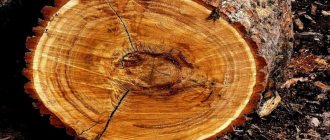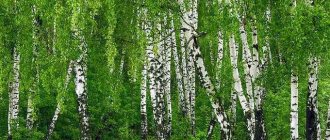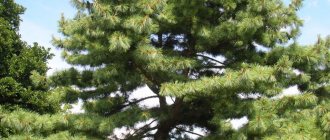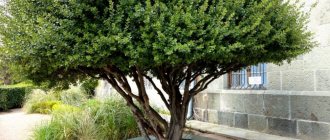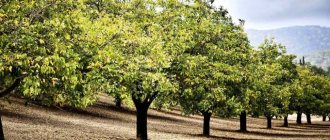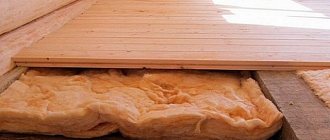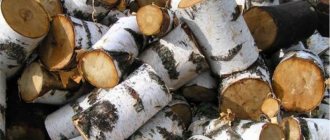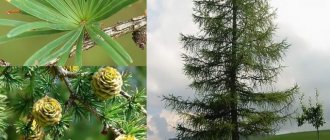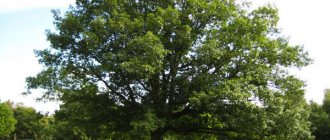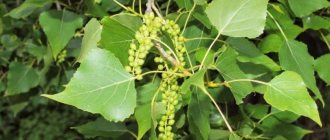General information, places of growth
Boxwood (Buxus colchica) is a shrub or small tree with a well-defined trunk and crown, with small, oval, dense, lingonberry-like leaves. They are located on the branches opposite, in pairs. Boxwood foliage is very dense and does not allow light to pass through.
A notable feature of boxwood is its exceptional shade tolerance. In this respect it is superior to all our other tree species. Boxwood trees can grow in the deep shade of mountain gorges under a dense, very dense forest canopy. The growth rings of boxwood are so small that they are indistinguishable to the naked eye.
One of the relict species listed in the Red Book is Colchian boxwood. This is an evergreen tree with small leathery leaves, up to 15-21 meters high, or a shrub. In the dense thickets of Colchian boxwood, twilight always reigns. Light green moss covers the trunks and hangs from the branches in intricate strands. Knobby tree roots intertwine on the soil surface. The boxwood crown in the plantings is quite light and multi-branched. The tree blooms in early spring, spreading its aroma. The fruits ripen in summer. The capsules open with a bang, scattering small black seeds up to 3 meters away.
Boxwood is a very slow growing species. Its increase in diameter per year is only one centimeter. It lives up to 500-600 years, but rarely reaches 60 centimeters in diameter.
Boxwood is found in Europe - in Northern France, Spain, Switzerland, Greece, but in the form of a shrub that has no timber trade value; on the islands of the Mediterranean Sea - Sardinia, Corsica and Minorca it reaches significant sizes. In Asia, boxwood grows on the Turkish coast of the Black Sea, in China - in the Shan Xi province, in India - on the southern slope of the Himalayan ridge; it also grows in Japan and Iran. Colchian boxwood was identified as a species by A.I. Poyarskaya in 1947. Its habitat is scattered. In Abkhazia, it is distributed south of the Psezuapse River to an absolute altitude of 1000 meters above sea level. Good plantings of Colchian boxwood are found in the gorges of the Yupshara, Gega, and Bzyb rivers. The seaside boxwood near the village of Tskurchili, Ochamchira district, also deserves attention.
As a tree species of a mild southern climate, boxwood most often settles in deep, windless gorges with stagnant air, under the protection of hornbeam, beech, ash, linden and other species. On Cape Pitsunda (the territory of the reserve) there are boxwood plantations with a total area of 64 hectares. They are valuable natural monuments and, undoubtedly, are of great scientific interest. One boxwood grove is located in the northwestern part of the reserve on the coastal strip, the other is near the village of Lidzava. The average height of trees here is 7-10 meters; age ranges from 50 to 180 years. Sometimes boxwood forms the second tier, and the first is represented by pine, hornbeam, and hornbeam.
In the northwestern part of the Pitsunda Grove, the plantings suffered greatly from the systematic impact of storm waves and splashes. After the storms of 1968 and 1970, trees dried out completely on an area of over two hectares. Other species (hornbeam, hornbeam) suffered less damage and quickly recovered.
Boxwood regeneration occurs very well in the first years, but with age a lot of it dies off. The undergrowth is represented by hawthorn, blackberry, broom, privet, and dogwood.
Boxwood grows very slowly, and in former times few people worried about its reproductive abilities. Currently, the need to restore boxwood trees is becoming an important problem. In this regard, it has become relevant to study the bioecology of the breed and those physical and geographical conditions in which boxwood develops better and grows faster.
Useful properties of boxwood for the benefit of people
Due to the abundance of chemical compounds, the crop is widely used to fight a cruel enemy - diseases. Alkaloids play a key role in the treatment of arterial hypertension. They stimulate the heart during arrhythmia or myocardial ischemia. The antibacterial effect of tannins helps with respiratory diseases. Phytoncides released by plant foliage are used to destroy harmful viruses. Purified air around the house is a wonderful place to relax.
In addition, the beneficial properties of boxwood are used in folk medicine. Various drugs are prepared from the plant and used in treatment:
- biliary tract;
- high temperature;
- vessels;
- joints;
- urinary system;
- open wounds;
- seborrhea.
Application of boxwood
Boxwood is interesting not only because it is a relic. It is of great economic value. Boxwood wood is one of the most valuable. Its quality in some respects exceeds the quality of the wood of all our other tree species. It is beautiful, ivory-colored, uniform in structure, dense and heavy, well processed and polished. The local population uses boxwood wood to make cups, candlesticks, spoons, forks, combs, mortars, shelves, and spindles. Currently, due to the small reserves of boxwood, the use of wood is limited only to the production of various valuable carved and turned products (souvenirs, parts for precision mathematical instruments, etc.)
Wood has lost its former glory because its reserves are almost exhausted. In the past, boxwood wood, for example from Georgia, was highly valued in foreign markets. During the period from 1842 to 1928, more than 90.5 tons of boxwood were exported abroad in the form of raw materials - meter-long cuttings. For this purpose, hundreds of thousands of the best trees were cut down, and only a small part of them was taken out of the forest. Harvesting boxwood was unsystematic and led to tree stands (in ripe and ripening form) to almost complete destruction. Boxwood trees have survived only in hard-to-reach places in the form of clumps, thinned out by logging. But they are also of great value; growing in gorges, they perform water protection, soil protection and often bank protection functions.
Boxwood is considered a valuable honey plant. Previously, its bitter, unpleasant-tasting bark and leaves were used in infusion as a diaphoretic and laxative. The oil extracted from them was recommended against toothache, scabs, etc. Boxwood leaves and branches are considered in some places the best fertilizer for grapes. Sawdust and leaves boiled in lye were used to dye hair chestnut. According to some statements, no animal touches boxwood seeds, and its leaves are considered poisonous to livestock, especially camels. They also claim that the toxicity sometimes inherent in Corsican honey depends on the fact that bees collect nectar and pollen from boxwood flowers.
Due to its eternal greenery, resistance to diseases and damage by insects, boxwood is widely used as a landscaping plant in the creation of parks, squares, as well as hedges and borders.
A storehouse of valuable components
The inconspicuous-looking plant contains an abundance of useful compounds. Under a microscope, scientists discovered:
- alkaloids;
- parabuxins;
- group B cyclocoreanines;
- bioflavonoids;
- phytoncides;
- essential oils;
- tannins;
- resin.
The unique composition of valuable elements explains the widespread use of the culture for the treatment of various ailments. For example, bioflavonoids affect enzyme activity and cell renewal. Essential oils and resins have antimicrobial properties. Tannins found in boxwood bark and foliage are used as an antiseptic.
Along with valuable compounds, the plant also contains toxic substances that are dangerous to the lives of people and animals.
Interesting facts about the boxwood tree
There is an ancient legend about boxwood. Once upon a time, the gods decided to give people immortality and send them living water. The carrier chosen was a common crow.
And so the bird descended from heaven and settled on a tree branch. She reasoned something like this: “Why do I bring water to people? I’d rather drink it myself and live forever.” And as soon as the crow placed the canister on a branch and bent down to drink the magic water, a gust of wind came and knocked over the can.
Water spilled onto the tree branches and was absorbed by the roots. By chance, this tree turned out to be a boxwood, which has now been growing for centuries, and the ancestors of the crow still mourn the loss with nasty croaks.
Many references to this wonderful tree are found in ancient Georgian fairy tales, Roman and Greek mythology, and legends of other peoples.
Useful properties of boxwood for a lush crown and beautiful hair
Evergreen shrubs are used not only to decorate city parks and summer cottages. It turns out that its valuable properties have a beneficial effect on hair volume. In combination with other medicinal crops, the effect of boxwood doubles.
The original tincture is made from the following herbs:
- nasturtium;
- nettle;
- boxwood
Take 100 g of all components. The raw materials are washed with water. Cut into small pieces. Place in a glass jar. Fill with pure alcohol (90%). Cover with a nylon lid. They are taken to a dark, cool place. Insist for at least 15 days. The drug is filtered and 3 tablespoons of olive oil are added. The resulting solution is rubbed into the scalp 2 times a week 30 minutes before washing your hair.
The miraculous properties of boxwood help stop the process of baldness. Traditional healers offer a simple tincture. Fresh buxus leaves (approximately 50-60 g) are cut in half. Fill with vodka (500 ml). Mix well. They insist for 14 days. The resulting medicine is rubbed into the head where there is no hair. The procedure is done every day using a small amount of tincture.
To improve the aroma, it is advisable to add rosemary or lavender essential oil to the liquid.
A similar drug for hair loss is prepared from the following set of components:
- boxwood;
- thyme;
- moonshine.
Herbs are used dry or fresh. Only high-strength moonshine is suitable. For 100 g of plant material, 1 liter of fiery liquid is sufficient. The grass is poured with homemade vodka and left for 15 days. Strain and then rub into the scalp where bald spots appear.
It is not shampoo that will help get rid of dandruff, but the juice obtained from boxwood leaves. The plant material is thoroughly crushed to form a paste. Then they put it in a gauze bag. Squeeze into a glass. The resulting juice is rubbed into the hair roots. Leave for 20-30 minutes. Wash off with hot water.
